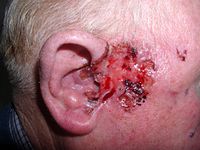
Photo from wikipedia
Importance Risk of cutaneous squamous cell carcinoma (cSCC) after the diagnosis of actinic keratosis (AK) has not been studied during long follow-up periods. Objective To estimate the risk up to… Click to show full abstract
Importance Risk of cutaneous squamous cell carcinoma (cSCC) after the diagnosis of actinic keratosis (AK) has not been studied during long follow-up periods. Objective To estimate the risk up to 10 years and identify risk factors for cSCC development. Design, Setting, and Participants This longitudinal cohort study, performed from January 1, 2009, to February 29, 2020, examined Kaiser Permanente Northern California patients with AK and control patients matched 1:1 on age, sex, race/ethnicity, medical center, and date of the initial diagnosis plus 30 days in the patients with AK. Exposures Patients with AK and control participants were followed up for up to 10 years for incidence of cSCC. Main Outcomes and Measures Incident cSCC was obtained from pathologic data, and subdistribution hazard ratios (HRs) and 95% CIs were estimated using Cox proportional hazards regression analysis, accounting for competing risks, calendar year, demographic factors, and number of AKs. Results The study included 220 236 patients with AK and 220 236 matched control patients (mean [SD] age, 64.1 [12.2] years; 231 248 [52.5%] female). After losses to follow-up were accounted for, risk of cSCC increased with each year of follow-up by 1.92% (95% CI, 1.89%-1.95%) in patients with AK and 0.83% (95% CI, 0.81%-0.85%) in matched control patients (subdistribution HR, 1.90; 95% CI, 1.85-1.95). However, among patients 49 years or younger, those diagnosed with AK were nearly 7 times more likely to be diagnosed with cSCC than those without AK (HR, 6.77; 95% CI, 5.50-8.32). At 10 years, the cumulative incidence of cSCC reached 17.1% (95% CI, 16.9%-17.4%) in patients with AK and 5.7% (95% CI, 5.5%-5.9%) in control patients. Increased numbers of AKs were modestly associated with increased cSCC risk (≥15 AKs vs 1 AK: subdistribution HR, 1.89; 95% CI, 1.75-2.04). Older patients had much higher risk of cSCC than younger patients (compared with those ≤49 years of age at AK diagnosis; ≥80 years of age: subdistribution HR, 8.18; 95% CI, 7.62-8.78). Other than AK, risk factors for cSCC included older age, White race (a proxy for skin type), history of basal cell carcinoma, and male sex. Risk decreased between 2009 and 2019 (2018-2019 vs 2009-2010: subdistribution HR, 0.67; 95% CI, 0.63-0.72). Conclusions and Relevance The results of this longitudinal cohort study can be used to develop recommendations to increase early detection of cSCC. Additional research is needed to understand the effect of AK treatment on cSCC risk and outcomes of cSCC.
Journal Title: JAMA dermatology
Year Published: 2021
Link to full text (if available)
Share on Social Media: Sign Up to like & get
recommendations!